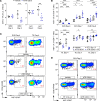The schedule of ATR inhibitor AZD6738 can potentiate or abolish antitumor immune responses to radiotherapy
- PMID: 36810257
- PMCID: PMC9977511
- DOI: 10.1172/jci.insight.165615
The schedule of ATR inhibitor AZD6738 can potentiate or abolish antitumor immune responses to radiotherapy
Abstract
Inhibitors of the DNA damage signaling kinase ATR increase tumor cell killing by chemotherapies that target DNA replication forks but also kill rapidly proliferating immune cells including activated T cells. Nevertheless, ATR inhibitor (ATRi) and radiotherapy (RT) can be combined to generate CD8+ T cell-dependent antitumor responses in mouse models. To determine the optimal schedule of ATRi and RT, we determined the impact of short-course versus prolonged daily treatment with AZD6738 (ATRi) on responses to RT (days 1-2). Short-course ATRi (days 1-3) plus RT caused expansion of tumor antigen-specific, effector CD8+ T cells in the tumor-draining lymph node (DLN) at 1 week after RT. This was preceded by acute decreases in proliferating tumor-infiltrating and peripheral T cells and a rapid proliferative rebound after ATRi cessation, increased inflammatory signaling (IFN-β, chemokines, particularly CXCL10) in tumors, and an accumulation of inflammatory cells in the DLN. In contrast, prolonged ATRi (days 1-9) prevented the expansion of tumor antigen-specific, effector CD8+ T cells in the DLN, and entirely abolished the therapeutic benefit of short-course ATRi with RT and anti-PD-L1. Our data argue that ATRi cessation is essential to allow CD8+ T cell responses to both RT and immune checkpoint inhibitors.
Keywords: Cancer immunotherapy; Immunology; Oncology; Radiation therapy; T cells.
Conflict of interest statement
Figures








Similar articles
-
ATR inhibitor AZD6738 enhances the antitumor activity of radiotherapy and immune checkpoint inhibitors by potentiating the tumor immune microenvironment in hepatocellular carcinoma.J Immunother Cancer. 2020 May;8(1):e000340. doi: 10.1136/jitc-2019-000340. J Immunother Cancer. 2020. PMID: 32461345 Free PMC article.
-
ATR kinase inhibitor AZD6738 potentiates CD8+ T cell-dependent antitumor activity following radiation.J Clin Invest. 2018 Aug 31;128(9):3926-3940. doi: 10.1172/JCI96519. Epub 2018 Aug 13. J Clin Invest. 2018. PMID: 29952768 Free PMC article.
-
Combining radiation and the ATR inhibitor berzosertib activates STING signaling and enhances immunotherapy via inhibiting SHP1 function in colorectal cancer.Cancer Commun (Lond). 2023 Apr;43(4):435-454. doi: 10.1002/cac2.12412. Epub 2023 Feb 28. Cancer Commun (Lond). 2023. PMID: 36855844 Free PMC article.
-
Targeting ATR in cancer medicine.Curr Probl Cancer. 2017 Jul-Aug;41(4):302-315. doi: 10.1016/j.currproblcancer.2017.05.002. Epub 2017 May 17. Curr Probl Cancer. 2017. PMID: 28662958 Review.
-
Immune checkpoint inhibitors with radiotherapy and locoregional treatment: synergism and potential clinical implications.Curr Opin Oncol. 2015 Nov;27(6):445-51. doi: 10.1097/CCO.0000000000000225. Curr Opin Oncol. 2015. PMID: 26447875 Review.
Cited by
-
Targeting ATR Pathway in Solid Tumors: Evidence of Improving Therapeutic Outcomes.Int J Mol Sci. 2024 Feb 27;25(5):2767. doi: 10.3390/ijms25052767. Int J Mol Sci. 2024. PMID: 38474014 Free PMC article. Review.
-
Uracil-DNA glycosylase deficiency is associated with repressed tumor cell-intrinsic inflammatory signaling and altered sensitivity to exogenous interferons.bioRxiv [Preprint]. 2025 Aug 1:2025.07.28.666960. doi: 10.1101/2025.07.28.666960. bioRxiv. 2025. PMID: 40766605 Free PMC article. Preprint.
-
Preclinical Evaluation of the ATR Inhibitor BAY 1895344 as a Radiosensitizer for Head and Neck Squamous Cell Carcinoma.Int J Radiat Oncol Biol Phys. 2024 Apr 1;118(5):1315-1327. doi: 10.1016/j.ijrobp.2023.12.012. Epub 2023 Dec 15. Int J Radiat Oncol Biol Phys. 2024. PMID: 38104870 Free PMC article.
-
Immunogenic cell death after combined treatment with radiation and ATR inhibitors is dually regulated by apoptotic caspases.Front Immunol. 2023 Jun 6;14:1138920. doi: 10.3389/fimmu.2023.1138920. eCollection 2023. Front Immunol. 2023. PMID: 37346039 Free PMC article.
-
ATR inhibition radiosensitizes cells through augmented DNA damage and G2 cell cycle arrest abrogation.JCI Insight. 2024 Oct 8;9(19):e179599. doi: 10.1172/jci.insight.179599. JCI Insight. 2024. PMID: 39235982 Free PMC article.
References
Publication types
MeSH terms
Substances
Grants and funding
LinkOut - more resources
Full Text Sources
Other Literature Sources
Medical
Research Materials
Miscellaneous

